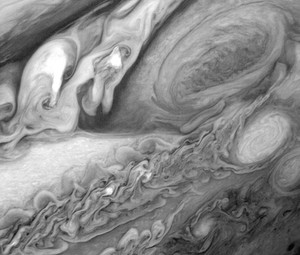A large oval feature in Jupiter’s clouds at about 22° south latitude. Its dimensions are currently about 18 000 km east–west and 14 000 km north–south; it has been shrinking in length fairly steadily for the past century. It was first recorded by S. H. Schwabe in 1831 but attracted little attention until 1878–82, when it became a striking dark red. Since then it has varied greatly in size, colour, and intensity, sometimes being so faint that it is detectable only by the hollow it makes in the South Temperate Belt (the Red Spot Hollow). A prominent, slightly smaller dark spot at a similar latitude to the Great Red Spot was seen in 1664 by the English scientist Robert Hooke (1635–1703), and lasted until 1713. This was probably an earlier manifestation of a similar phenomenon. Space probes have shown the Great Red Spot to be a vast vortex rotating anticlockwise (anticyclonically), equivalent to a storm or hurricane. At the time of the Voyager encounters in 1979 its rotation period was about 7 days, but 30 years later had speeded up to about 4.5 days. Its top lies a few kilometres above the surrounding cloud deck, and its red colour may be due either to compounds such as phosphine (PH3) rising from lower layers or to ammonia and acetylene being broken down at altitude by solar ultraviolet light. A smaller version of the Great Red Spot arose at 34° south following the merger of three white oval storms in 1998 and 2000. Initially it remained white, like the storms from which it formed, but took on a ruddy colour in late 2005, presumably as complex chemicals were brought up from deeper within Jupiter’s clouds.
 http://hubblesite.org/image/2440/news_release/2008-42
http://hubblesite.org/image/2440/news_release/2008-42
A prominent oval feature, 14 000 km wide and some 30 000 km long, in the atmosphere of the planet Jupiter, south of its equator. It was first observed in 1664. Space probes show it to be an anticlockwise vortex of cold clouds, coloured possibly by phosphorus.

Enhanced view of Jupiter’s Great Red Spot region. Below the Great Red Spot are two more cyclonic storms. The Voyager image was among the first to reveal the incredibly turbulent flow within Jupiter’s zonal bands, which from afar look stable and placid.
Credit: NASA
An anticyclonic storm system in the hydrogen–helium atmosphere of the southern hemisphere of Jupiter. It covers 10° of latitude, is about 12 000 km across (close to the diameter of the Earth), and has been observed for more than 300 years.
- Torridonian
- torrid zone
- torsion
- torsional strain
- torsion angle
- torsion balance
- torsion element
- torta
- tortoise
- Tortonian
- torus
- Torvalds, Linus Benedict (1969–)
- Tory
- toscanite
- total acid number
- total annual costs
- total capacitance
- total condenser
- total core recovery
- total correctness, proof of
- total cost
- total differential
- total dissolved solids
- total domestic expenditure
- total eclipse